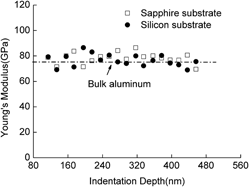Article contents
Extracting the elastic moduli of the constituent layers of a multilayered thin film from nanoindentation tests
Published online by Cambridge University Press: 11 September 2013
Abstract

Multilayer thin films have been widely used for their enhanced mechanical and tribological properties relative to the monolayers of equivalent thickness. However, the mechanical properties of the each constituent layer are rarely investigated due to the difficulty in separating the effects of the constituent layers. An inverse analysis method to identify the elastic moduli of the constituent layers of multilayer films is developed by fitting the finite element calculations with indentation measurements within the framework of numerical optimization. The method is verified against typical monolayer, bilayer, and trilayer film structures both numerically and experimentally. Uniqueness and substrate-independence of the extracted moduli are ensured by the multiple loading–unloading cycles of the indentation tests. The method provides a feasible way to characterize the intrinsic mechanical properties of the constituent layers of multilayered thin films and further to explore the dominant mechanism for the enhancement of their mechanical properties.
- Type
- Articles
- Information
- Copyright
- Copyright © Materials Research Society 2013
References
REFERENCES
- 2
- Cited by




